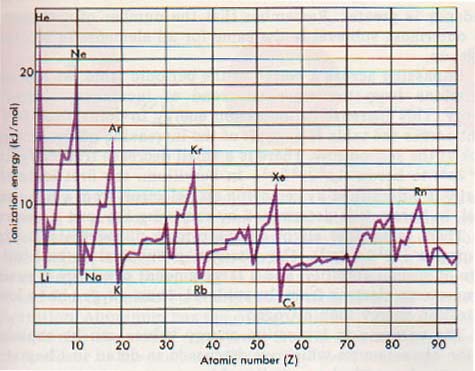
The energy necessary to remove an atom of its electrons is known as ionisation energy (s). When the ionisation energy trend is followed, it also shows an ionic radius trend.Įlectronegativity is a measurement of whether an element’s atoms tend to lose electrons or rob atoms of their electrons. The atomic radius trend across the periodic table is depicted in this diagram. On a periodic table, moving from the top right to the bottom left illustrates an increase in atomic radius. The periodic table of elements is set up in such a way that the atomic radius of each element follows a trend. The size of a neutral atom is measured in atomic radius. Because fluorine has the most protons in this series, it has the strongest influence on its ten electrons, pulling them tightly around the nucleus and reducing its ionic radius. Nitrogen, for example, contains seven protons compared to eight for oxygen and nine for fluorine, hence nitrogen nuclei have a weaker attraction on their electrons and thus a bigger ionic radius. As a result, each anion has a unique ionic radius. Furthermore, their nuclei have variable degrees of effect on their 10 electrons due to their different quantities of protons. The anions described above all have ten electrons, but because of their different protons, they have various negative charges. The following ions, for example, have the same number of electrons and are thus in an isoelectronic series:Īs their varying numbers of protons, nitrogen (N), oxygen (O), and fluorine (F) can all gain various numbers of electrons and end up with the same number of electrons but distinct charges. As a result, they exert a stronger pull on electrons, drawing them closer together and reducing the atoms or ion’s total radius. The positive charge of an atom increases as the number of protons increases. Because protons have a positive charge, they have an effect on electrons who have a negative charge. The nuclei of other elements have differing numbers of protons. This does not, however, imply that they will have the same ionic radius. When an atom loses an electron, it transforms into a positively charged ion known as a cation, which has a smaller ionic radius.ĭifferent elements’ ions can be isoelectronic, meaning they contain the same number of electrons. When an atom gets an extra electron, it transforms into a negatively charged ion known as an anion, which has a larger ionic radius. When an atom receives or loses an outermost electron, the ionic radius describes the change in size (i.e., radius) (s). Ions are atoms that gain or lose electrons. Because electrons are negatively charged, they affect the charge of an atom when they receive or lose them. Ionisation also allows atoms to gain or lose their outermost electrons, increasing or decreasing their total size.

Other elements’ atoms are made up of varying amounts of subatomic particles and so have varying sizes.

Regardless, scientists calculate the diameter of atoms of various elements and model them as solid spheres. Ionic radius and periodic tableĪs of the probabilistic wave function behaviour of electrons and the electron cloud, atoms have ambiguous sizes. The number of electrons acquired or lost can cause an element’s atoms to have differing ionic radii depending on whether they are a cation (positive ion) or an anion (negative ion). The radius of an atom can increase or decrease when it becomes an ion, and this is known as the atom’s ionic radius. The atomic radius of a neutral atom equals its diameter.

If an atom receives or loses an electron and becomes positively or negatively charged, it forms an ion. The atomic and ionic radii of atoms differ.


 0 kommentar(er)
0 kommentar(er)
